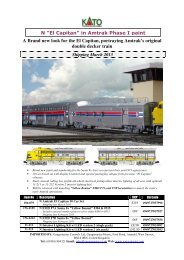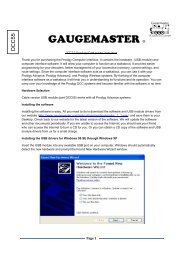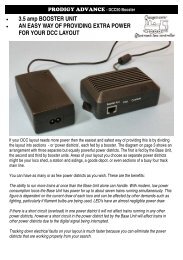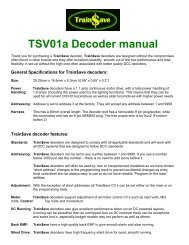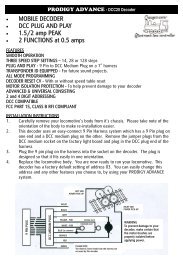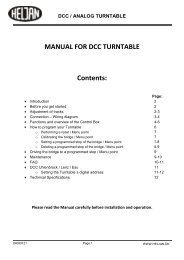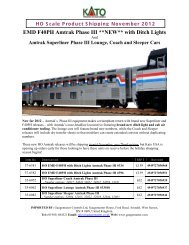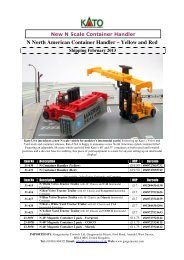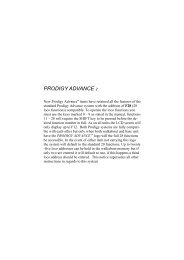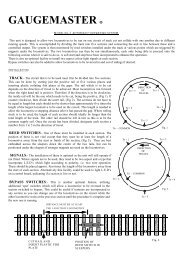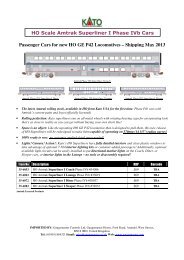10810 multiMAUS - Fleischmann
10810 multiMAUS - Fleischmann
10810 multiMAUS - Fleischmann
You also want an ePaper? Increase the reach of your titles
YUMPU automatically turns print PDFs into web optimized ePapers that Google loves.
to be as long as the longest train. It is double-pole insulated on both sides. The change-over section of<br />
track is now monitored and changed accordingly by the separator module when the train passes over the<br />
separating point. Drive operation on the rest of the system remains unaffected.<br />
THE 10765 BOOSTER<br />
You require a booster if the system often switches off without the occurrence of a short circuit, i.e. no locomotive<br />
or carriages have derailed and there are no faults in the wiring. In this case, there is an overload<br />
due to too many consumers (locomotives, illuminated carriages etc.). The booster connects an additional<br />
transformer (ROCO 10725 or 10718), provides more energy and thus clears the overload.<br />
Two boosters must not be connected to the same transformer! Each of these devices requires its own<br />
voltage supply.<br />
Connecting one or more boosters 10765<br />
Divide up the system into separate supply sections so that the number of consumers in each supply section<br />
is as evenly distributed as possible. You calculate the power consumption in a section as follows:<br />
• Stationary locomotives with light, approximately 100 mA<br />
• Travelling locomotives from approximately 300 to 600 mA depending on size and load<br />
• Illuminated carriages, approximately 30 mA depending on the bulb<br />
• Digital coupling or smoke generator, approximately 100 mA<br />
If the power consumption exceeds 2.5 A, the section will be overloaded and will need to be divided up. You<br />
must also make sure there are large tolerances in the current consumption, especially for light bulbs. Use<br />
the 42624 digital turnout drive or connect another turnout decoder directly to the drive circuit. You will<br />
then have to calculate approximately 500 mA reserve for the switching current of the turnout.<br />
If you have ensured that the system has a sufficient supply of power, the division of the booster sections is<br />
of no significance to the reliability of commands, for drive operation or for switching turnouts.<br />
Switch off the system before installing a booster. Divide the system into supply sections. Disconnect the<br />
tracks electrically from each other in the respective places (on both sides!) wether using ROCO insulating<br />
rail connectors 42611 or 61192, insulated track or by sawing the rail profiles. Install a section of power<br />
track (e.g. 61190) in the new supply section and connect it to the “Track Out” socket on the booster. Connect<br />
the booster to its transformer. Then connect 10765 booster to amplifier 10764 with the special cable<br />
included in the box by plugging it into the socket marked “Booster Out” on amplifier 10764 and the socket<br />
marked “Booster In” on booster 10765. Fig. 3 on page 62 shows the complete wiring.<br />
If required, you can connect further boosters to the “Booster Out” socket of the 10765 booster. A maximum<br />
of four 10765 boosters can be connected to the 10764 amplifier.<br />
However, for large systems more than four 10765 boosters can be connected in conjunction with a 10779<br />
braking generator. The 10764 amplifier, 10765 booster and braking generator have to be connected in the<br />
following sequence:<br />
10764 (or 10761) – 3 x 10765 – 10779 – 3 x 10765 – 10779 etc.<br />
Make sure that the tracks have the same polarity at the change-over turnout so that short circuits are<br />
not caused when a train passes over the separating turnout. If a short circuit occurs, turn the power<br />
track plug 180°.<br />
It is imperative that you make sure that the power track does not contain any capacitors.<br />
<br />
55



